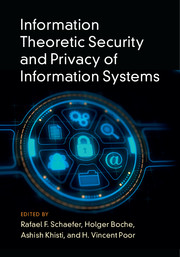Book contents
- Frontmatter
- Contents
- List of Contributors
- Preface
- Part I Theoretical Foundations
- Part II Secure Communication
- Part III Secret Key Generation and Authentication
- Part IV Data Systems and Related Applications
- 15 Information Theoretic Analysis of the Performance of Biometric Authentication Systems
- 16 Joint Privacy and Security of Multiple Biometric Systems
- 17 Information Theoretic Approaches to Privacy-Preserving Information Access and Dissemination
- 18 Privacy in the Smart Grid: Information, Control, and Games
- 19 Security in Distributed Storage Systems
- Index
- References
17 - Information Theoretic Approaches to Privacy-Preserving Information Access and Dissemination
from Part IV - Data Systems and Related Applications
Published online by Cambridge University Press: 28 June 2017
- Frontmatter
- Contents
- List of Contributors
- Preface
- Part I Theoretical Foundations
- Part II Secure Communication
- Part III Secret Key Generation and Authentication
- Part IV Data Systems and Related Applications
- 15 Information Theoretic Analysis of the Performance of Biometric Authentication Systems
- 16 Joint Privacy and Security of Multiple Biometric Systems
- 17 Information Theoretic Approaches to Privacy-Preserving Information Access and Dissemination
- 18 Privacy in the Smart Grid: Information, Control, and Games
- 19 Security in Distributed Storage Systems
- Index
- References
Summary
The Internet has revolutionized the process of obtaining and sharing information. However, this functionality comes hand-in-hand with pervasive, often subtle, privacy violations. In this chapter, we discuss algorithmic approaches for accessing and disseminating information while protecting the privacy of network users. In particular, we focus on mechanisms that offer information theoretic privacy guarantees; that is, these mechanisms offer protection even against computationally unbounded adversaries. We provide a high-level overview of various classes of privacy-preserving algorithms, with concrete intuition-building examples.
Introduction
People today generate, share, and consume information with unprecedented efficiency. The Internet has enabled realities that seemed impossible a few decades ago: instantaneous global message dissemination, large-scale data storage at minimal cost, and lightning-fast information search and retrieval, to name a few. However, these advances come hand-in-hand with unique privacy threats, which were largely ignored in the push to develop seamless user experiences. Namely, the very information that users willingly consume and produce on the Internet can be deeply revealing about the users themselves. More problematically, leakage of this information poses a significant privacy risk, which can have serious societal repercussions, both psychological and physical [1,2]. In this chapter, we explore several privacy challenges and offer solutions associated with two key aspects of information flow: data dissemination and data access.
When people disseminate information – for instance, by posting a message on a social network – they can inadvertently reveal sensitive information about themselves. Sometimes, this information might be inherent to the content a user posts. For example, if Alice posts on Twitter that she is going to the cinema at 8 pm, then she is implicitly telling her contacts that she will not be home at 8 pm; in the worst case, this could facilitate a robbery. Such content-based data leakage is inevitable, and must be managed by educating users about the privacy implications of posting personal information. However, sometimes information dissemination can also cause unintentional leakage of metadata, or data that is not directly related to content. For example, if Alice posts a picture of her cats to a social network at 3 pm, and the social network includes her GPS location when it propagates the message to her contacts, then Alice's contacts could learn her location at 3 pm.
- Type
- Chapter
- Information
- Publisher: Cambridge University PressPrint publication year: 2017

